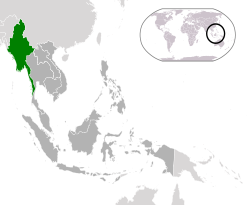State Law and Order Restoration Council
| Union of Myanmar | ||||||||||
|
ပြည်ထောင်စု မြန်မာနိုင်ငံတော် Pyidaunzu Myăma Nainngandaw |
||||||||||
|
||||||||||
|
||||||||||
|
Anthem Kaba Ma Kyei Till the End of the World |
||||||||||
| Capital |
Rangoon (1988–2006) Naypyidaw (2006–2010) |
|||||||||
| Languages | Burmese | |||||||||
| Religion | Buddhism | |||||||||
| Government | Military junta | |||||||||
| Chairman | ||||||||||
| • | 1988–1992 | Saw Maung | ||||||||
| • | 1992–2011 | Than Shwe | ||||||||
| Vice-chairman | ||||||||||
| • | 1988–1992 | Than Shwe | ||||||||
| • | 1992–2011 | Maung Aye | ||||||||
| Prime minister | ||||||||||
| • | 1988–1992 | Saw Maung | ||||||||
| • | 1992–2003 | Than Shwe | ||||||||
| • | 2003–2004 | Khin Nyunt | ||||||||
| • | 2004–2007 | Soe Win | ||||||||
| • | 2007–2011 | Thein Sein | ||||||||
| Historical era | Cold War | |||||||||
| • | 8888 Uprising | 18 September 1988 | ||||||||
| • | House arrest of Aung San Suu Kyi | 20 July 1989 | ||||||||
| • | Saffron Revolution | 15 August 2007 | ||||||||
| • | Renamed to the Republic of the Union of Myanmar | 10 May 2008 | ||||||||
| • | Aung San Suu Kyi released | 13 November 2010 | ||||||||
| • | SPDC dissolved | 30 March 2011 | ||||||||
| • | Elections | 8 November 2015 | ||||||||
| Area | ||||||||||
| • | 1988 | 676,578 km² (261,228 sq mi) | ||||||||
| Currency | Kyat | |||||||||
| Calling code | +95 | |||||||||
|
||||||||||
| Today part of |
|
|||||||||
The State Peace and Development Council (Burmese: နိုင်ငံတော် အေးချမ်းသာယာရေး နှင့် ဖွံ့ဖြိုးရေး ကောင်စီ [nàɪɴŋàɴdɔ̀ ʔédʑáɴθàjajé n̥ḭɴ pʰʊ̰ɴbjó jé kaʊ̀ɴsì]; abbreviated to SPDC or နအဖ, [na̰ʔa̰pʰa̰]) was the official name of the military government of Burma (also known as Myanmar), which seized power in 1988. On 30 March 2011, Senior General Than Shwe signed a decree that officially dissolved the Council.
From 1988 to 1997, the SPDC was known as State Law and Order Restoration Council (SLORC), which had replaced the role of Burma Socialist Programme Party (BSPP). In 1997, SLORC was abolished and reconstituted as the State Peace and Development Council (SPDC). The powerful regional military commanders, who were members of SLORC, were promoted to new positions and transferred to the capital of Rangoon (now Yangon). The new regional military commanders were not included in the membership of the SPDC.
The SPDC consisted of eleven senior military officers. The members of the junta wielded a great deal more power than the cabinet ministers, who are more junior military officers, or civilians. The exception is the Defence Ministry portfolio, which was in the hands of junta leader Than Shwe himself. On 15 September 1993, it established the Union Solidarity and Development Association which was replaced by Union Solidarity and Development Party in 29 March 2010 in time for the elections.
Although the regime retreated from the totalitarian Burmese Way to Socialism of BSPP when it took power in 1988, the regime was widely accused of human rights abuses. It rejected the 1990 election results and kept Aung San Suu Kyi under house arrest until her release on 13 November 2010. The council was officially dissolved on 30 March 2011, with the inauguration of the newly elected government, led by its former member and Prime Minister, President Thein Sein.
...
Wikipedia




